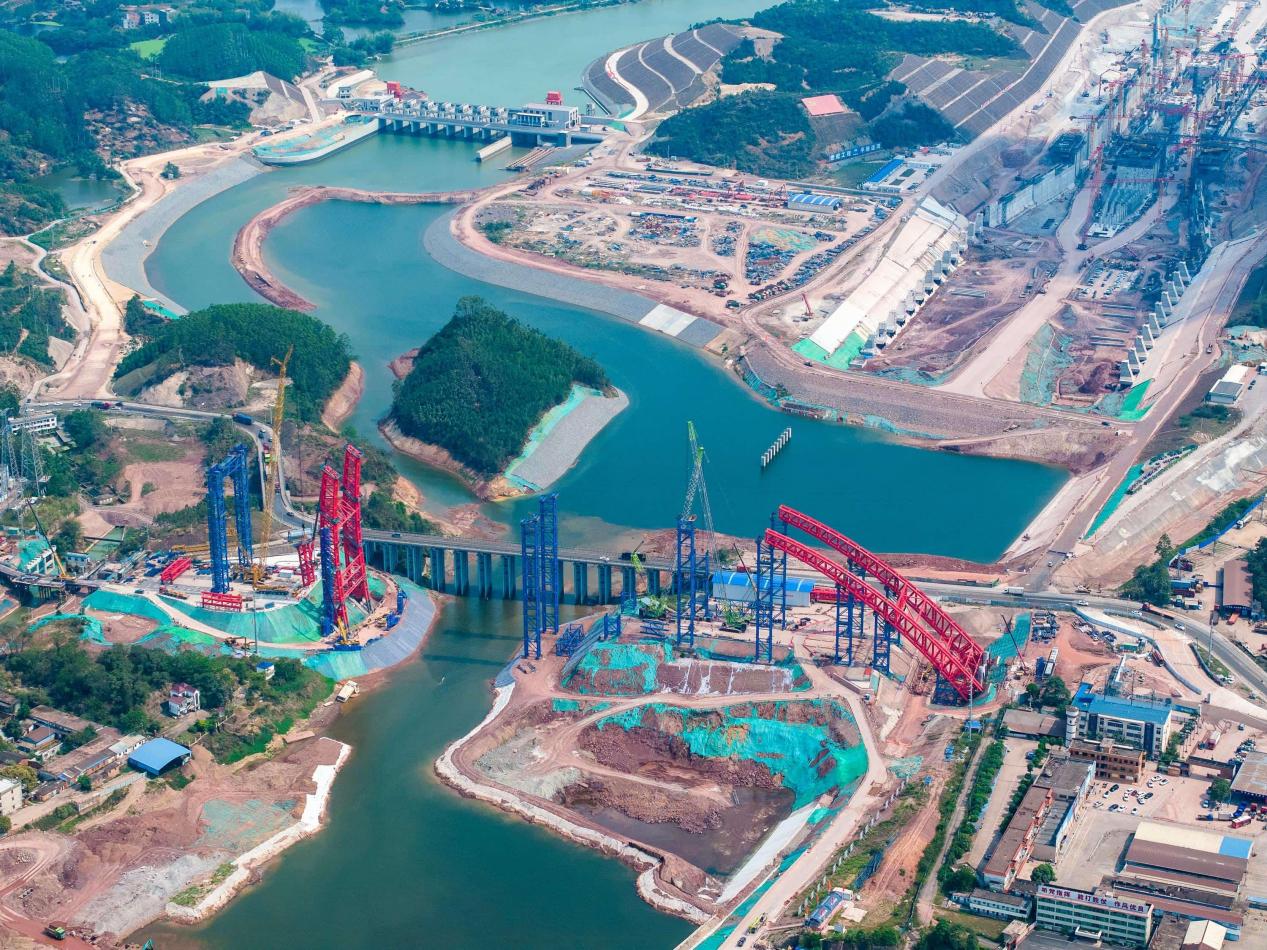Pinglu Canal takes shape, breathing new life into the Beibu Gulf

The Madao cascade hub of the Pinglu Canal in Qinzhou, south China's Guangxi Zhuang autonomous region is under construction, Oct. 26, 2025. (Photo/Zeng Xiangzhong)
The Pinglu Canal, the first river-to-sea canal built since the founding of the People's Republic of China, is nearing completion after over three years of intensive construction. As a backbone project of the New International Land-Sea Trade Corridor in western China, the canal spans 134.2 kilometers, linking the Pingtang River estuary in Nanning, Guangxi Zhuang autonomous region, to the Beibu Gulf via the Qinjiang River.
Today, the canal's channel has largely taken shape. Towering sluice hubs line its banks, and its wide, sunlit waterway -- stretching over 100 meters in width -- quietly channels water toward the sea, signaling a transformative shift in regional connectivity.
A strategic link in the Chinese national infrastructure
A close look at the map of China reveals an intricate network of rivers crisscrossing Guangxi -- from west to east, the Xijiang, Hongshui, Qianjiang, and Guijiang Rivers meander like the veins of a phoenix tree leaf. The Pinglu Canal serves as the vital petiole connecting this inland network to the sea, functioning as a "lifeline" for waterborne transport in the region.
The canal integrates with the Xijiang shipping trunk line upstream, extending westward via the Zuojiang and Youjiang Rivers into Yunnan, eastward through the Yujiang River to the Guangdong-Hong Kong-Macao Greater Bay Area, and northward via the Qianjiang and Hongshui Rivers into Guizhou. To the south, it opens into the Beibu Gulf, establishing a direct inland waterway to the sea. Designed as a Class I inland waterway, the Pinglu Canal will accommodate 5,000-ton vessels, enabling seamless connectivity between inland provinces and global maritime trade routes.
Despite its coastal geography, Guangxi's rivers historically flow eastward into the Pearl River Delta due to complex topography and elevation differences, leaving the region without a direct river-to-sea route. As a result, goods from western China have traditionally faced extended transport routes to reach international ports.
"Inland waterway transport offers substantial advantages over rail and road. It handles higher cargo volumes, lower costs, and reduced emissions, making it a critical element in optimizing China's transport infrastructure," said Yan Qiang, director of the science and technology information department at the Pinglu Canal Group.
Yan emphasized that the canal's construction is driven by its significant and unique strategic value. "Once operational, it will greatly enhance the efficiency of trade between Guangxi, southwestern China, ASEAN, and beyond. Compared with the route through Guangzhou Port, the canal will shorten the journey by over 560 kilometers and save more than 5.2 billion yuan (approximately $731 million) in annual freight costs."
Engineering marvel with multifunctional benefits
The project encompasses the construction of a 134.2-kilometer-long, 5,000-ton-class inland waterway, three double-lane ship lock hubs, 27 newly built or reconstructed bridges, and supporting facilities.
"Unlike the Suez or Panama Canals, the Pinglu Canal is designed as a modern, multifunctional waterway that integrates navigation, flood control, water supply, irrigation, and ecological preservation," explained Yan. "Constructing such a complex system under tight deadlines, within challenging terrain and strict environmental constraints, has been a formidable engineering challenge."
Inside the project's central command and control center, two real-time metrics that reflect the scale of construction progress: earth and rock excavation, and concrete volume poured.
To carve the canal's path through mountainous terrain, excavation has reached 315 million cubic meters -- nearly triple the volume excavated for the Three Gorges Project. Simultaneously, concrete pouring for the canal's three cascade ship lock hubs -- Madao, Qishi, and Qingnian -- has reached 5.84 million cubic meters, enough to fill more than 2,300 standard swimming pools. These locks collectively manage a water level drop of approximately 65 meters, essential for vessel navigation.
"As of now, over 97 percent of the channel excavation has been completed, 80 percent of the banks have been reinforced, and water has been introduced to an initial 18-kilometer section," said Mo Rixiong, project manager at CCCC Guangzhou Dredging Co., Ltd., noting that the project has entered its final phase.

The Qingnian cascade hub of the Pinglu Canal in Qinzhou, south China's Guangxi Zhuang autonomous region is under construction, April. 23, 2025. (Photo/He Huawen)
A catalyst for regional development
As the Pinglu Canal nears full connectivity, its strategic importance is only beginning to unfold. Beyond its engineering significance, the canal is poised to become a powerful engine of regional development.
Major industrial projects are taking shape along its route. Nanning BYD New Materials Co., Ltd. has launched a lithium carbonate project with an annual capacity of 30,000 tons, while Sun Paper is investing 20 billion yuan in a fully integrated forest-pulp-paper industrial park. These key investments, driven by industry leaders, are laying the groundwork for an emerging industrial cluster and generating future cargo sources for the canal.
Supporting infrastructure is also undergoing rapid transformation. Key logistics nodes -- such as Nanning Port and associated transportation facilities -- are being modernized to ensure efficient operations once the canal is fully navigable.
"The Pinglu Canal is not just a major infrastructure project," said Yan. "It's a catalyst for unlocking industrial potential across the region, building a true 'canal economic belt' that drives regional development and prosperity."
Photos
Related Stories
Copyright © 2025 People's Daily Online. All Rights Reserved.









